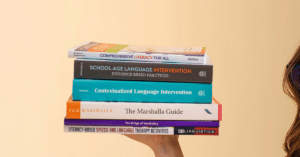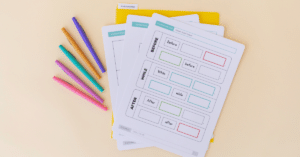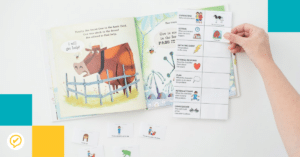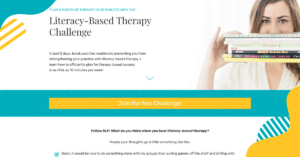I so enjoyed co-hosting and presenting at the SLP Summit! I always enjoy the opportunity to connect with so many SLPs around the world through this online conference, and this year was no exception!
This year, I dove into evidence-based strategies for grammar intervention.
If you missed the live video, then you can find the replay in the SLP Now Academy.
Now let’s dive into some of your questions…!
1. Teaching
I have two students who continue to use the same grammar errors over and over in conversation. They are able to fix the errors when I say the sentence back to them the way they used it. Do you have anything that you have found to help in this situation?
It’s hard to tell without knowing the students, but I always look back at the framework when I feel stuck! Here are the questions I ask myself:
• Did I take a step back and teach the concept?
• Did I provide enough models before requiring a response?
• Have I used evidence-based structured practice activities (e.g., imitating contrasting sentences)?
I usually find my answer when I think through those steps!
Do you have any strategies for teaching students the meaning of different conjunctions? My students understand when to use “and,” “but,” and “or” but have difficulty with “for” and “so.”
These can be challenging to teach because they are so abstract! I provide simple definitions for the different conjunctions. I follow that up with plenty of examples that are relevant to the student (e.g., topics around their daily routine, their favorite movie characters, etc.) so they have as much background knowledge as possible—making it easier to understand and visualize the meaning of those more challenging sentences.
Here are some examples:
• and = connects (Half of the class took a test, and the other half went to recess.)
• but = however (I tripped on a rock, but I didn’t drop my art project.)
• or = otherwise (Start studying now, or you’ll fail the test.)
• for = because (I felt guilty, for I knew it was my fault my sister didn’t get to eat breakfast.)
• so = for this reason (I was sick, so I went to the doctor.)
We move through the hierarchy (starting with teaching and ending with embedded practice) to give them countless scaffolded opportunities to master the concept!
2. Focused Stimulation
When you recast a student’s sentence, do you ask them to repeat your model so they get practice verbalizing the correct sentence structure?
It depends! We want the student to have enough exposure to the concept before requiring them to repeat the sentence. The slides reference some studies that break this down a little more!
3. Structured Practice
Is the Imitating Contrasting Sentences activity available on SLP Now?
Yes! If you’re not already a member, then you can sign up for a free trial here.
Feel free to send us a message if you would like help finding a specific activity.
How would you implement the sentence mat for compound sentences with older students (high school) who have also been diagnosed as ID? Would it essentially be the same as for younger students? I love the idea, but I’m not sure how to implement it for my students.
You know your students best, so I can’t answer for your students specifically. That said, I personally have used the sentence mats with elementary and secondary students. I make sure to meet the students where they are at (e.g., by selecting appropriate sentences), but the visuals are quite versatile!
Any suggestions for irregular past tense verbs? It is so hard because drill seems to be the best way for memorizing these verb forms.
I’ve had success using the same framework (e.g., teaching, focused stimulation, structured practice, embedded practice). When it comes to drill, the “imitating contrasting sentences” strategy is one of my favorites. I select targets and cycle through those. This is my hypothesis, but I think the teaching phase helps increase students’ overall awareness, giving them the tools they need to start generalizing as they master the target list.
4. Embedded Practice
What was the app you used on the “crack the egg” example?
Cookie Doodle. Such a fun and versatile app!
Which YouTube videos do you use during your speech sessions the most?
I love Pixar Shorts and have been able to use them with a wide range of students.
For older students, I often get permission to use their favorite shows. (I couldn’t ask for a better generalization opportunity!)
Bonus!
How do you write an IEP goal to incorporate the goals when they have so many grammar goals to work on? Do you list each goal individually (e.g., past tense, pronouns, etc.), or is there a way to write a goal that incorporates several targets? My county supervisors want me to write very few goals, but I feel that when I do this, it really doesn’t make the goal measurable.
I usually keep my goals broader when it comes to grammar/syntax. I do list the targets that I’ve identified so that the IEP team is aware of the targets.
Here’s one example:
Student will produce grammatically correct sentences (e.g., appropriate use of pronouns, subject/verb agreement, and irregular past tense verbs).
Just add the criterion (e.g., in 4/5 opportunities, with 80% accuracy) and any other components that you need to add to your goal (e.g., when given ___ support, by ___ date).
You can also get more specific with the context (e.g., in conversation, when retelling a story, during classroom discussions), if needed!
Can you post the titles of the articles and where we can get them?
We mentioned several research articles throughout the presentation. The list of references can be found in the presentation slides. However, there were two articles that were particularly helpful. You can find the Connell (1982) article here, and you can find the Strong (1986) article here!
Thanks again for another amazing SLP Summit!
Leave a comment below if there were any questions that we didn’t get to!






Leave a Reply